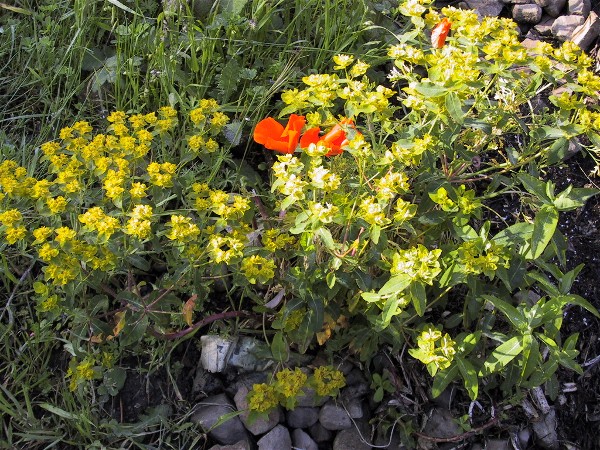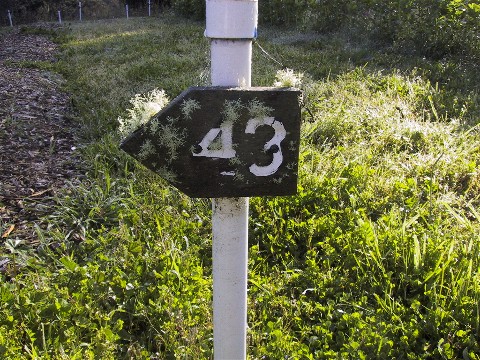

On my latest visit to the garden I happened to be there alone, and in the silence of the day I realized another part of the peace of that spot. The spring weather and the absence of wind gave a wonderful opportunity to hear the songs and calls of the many birds that live among and around the garden, each type with its unique voice. To name a few, there were the Pigmy Nuthatches, the Spotted Towhees, the Violet-green Swallows circling and calling overhead, a Raven in the distance, and a Winter Wren singing in the forest like a canary on speed. Robins and Song Sparrows visit the garden and Hummingbirds frequent the flowers near the memorial bench. I’m sure the lovely birdbath in the herb garden has welcomed greater numbers and species than we’ve ever had before. Many of these birds are insectivores, eating flying insects on the wing or foraging among the compost for ground-dwelling pests that might do harm to our crops. And some are scavengers, cleaning up after the earthly end of life of other creatures.
The other day on my visit to the garden, I was happy to see a Chickadee popping into the birdhouse we have mounted on the power pole in the old artichoke bed. He was making frequent trips to a local fir tree and carrying nesting material into the house. Watch for this family from a distance. There’ll be a lull in their activity while they sit on eggs for a couple of weeks. Then the work begins as their young start to make feeding demands, probably in mid-May, if all goes well. Chickadees also feed on insects. With friends like these, who needs insecticides?
Then there are the California Quail, extolling the latest Academy Award winner, “Chicago.” They’re not so friendly to our crops, and that’s why we use Reemay or netting covers for some of our plantings. But really, there is enough for all once things get growing vigorously, and I’d miss the quail families that visit us often, the somewhat drab females with their broods of chicks scurrying through the shrubs on the west side of the garden, and the speckle-chested and top-knotted males that often sit above on a fence post as sentry for their flock.
A problem may arise this year with the ever-increasing turkey clans that forage the Ranch. Late last summer, we began to see them in the garden for the first time. As wild greens outside the garden began to disappear, they seemed to grow attracted to some of our lush foliage. They are big enough to do damage, and I’m afraid we may need to learn to get along with them, maybe at the dinner table. Got any less sinister ideas that live lightly on the land? The Steering Committee will welcome them.

In memory of Doris Buck, an arbor will be raised over our Memorial Bench.
Flowering vines will climb upon the graceful structure. Labor will be lovingly donated, but the materials will cost around $600. Steering Commmittee members have started a fund, and invite contributions from other Gardeners as well. To contribute, make your check out to "The Posh Squash," and note on it "Doris Buck Memorial Arbor Fund." Give or send your check to Tom Warnock, Mary Austin or Rosemarie Hocker, or to your Day Leader.
Since many Gardeners did not have the experience of gardening with Doris, our exemplary Gardener, TCH asked her good friends, Mary Austin and Sally Skibbins, to reminisce. They ask, "Who Was Doris Buck?" and fondly answer.
WHO WAS DORIS BUCK?
Doris was a 5'2" brown-eyed bundle of enthusiasm and energy, an inveterate volunteer who has been described as "fire under control." She ran the Posh Squash garden with skill and determination throughout the 1990s until she passed away in 2002. This "Mighty Mite" (her high school nickname) brought with her some garden skills when she arrived at the Sea Ranch in 1988. These were further honed by working with "Blackie" Blackburn and Gordon Beebe, and led to her becoming chief Gardener after they were gone. Under her daily care, the Posh Squash flourished for over a decade with tried and true crops and now and then a daring innovation (remember okra and soy beans?) The present Gardeners are hugely indebted to Doris for her part in the wonderful garden they enjoy today.
One memory remains still - her appreciation of what she called "soft days" - cool, overcast and, in her opinion, perfect for another day of gardening. First, though, she would stand at the top of the garden momentarily to enjoy the serenity, before pulling out the Chore Book and putting her crew to work in the place she loved.

This year in the Posh Squash you will find flowers and herbs in old and newplaces. These plants have been selected to attract and feed beneficial insects, butterflies, pollinating insects, bees and birds.
Down the center aisle, at the end of each vegetable bed, and scattered throughout some beds, plants will be grown which will be of benefit to the vegetables in many ways. These flowers and herbs will either provide home to beneficial insects or confuse unwanted pests. Bed 37 will be planted with a mixture of herbs and flowers all of which will help attract and feed these insects. These bugs, e.g. lacewings, ladybugs, syrphid and tachinid flies, trichogramma wasps, cannot harm humans but will act as predators and parasitics to undesirable bugs like aphids. We will not pick the plants in this bed.
In Bed 53 and all existing flower beds we will continue to grow those plants which attract needed pollinators, the bees and hummingbirds, and those plants which serve as nectar sources for butterflies. So look for dill, baby blue-eyes, forget-me-not, aster, bishop's flower, cilantro, chamomile, sunflower, fennel, amaranths, cleome, zinnias, holy basil, purple millet, and oooooh so much more... look all around... Kate Frey of Fetzer Gardens says it well: "Constant activity, beneficial to man, beast and nature, flowers appealing to bird, man and insects -- such is a habitat garden. No one should be without one."

The Steering Committee met Friday, April 25, 2003 at the Del Mar Center. Present were Co-chairs Tom Warnock and Mary Austin, and Ken Holmes, Sally Skibbins, Jer Skibbins, Jim Grenwelge, Dianne Rasmussen, MA Brauer, and your faithful scribe, Chester Case.
“The Garden has never looked better, ever,” asserted a long-time Gardener who can be believed, for sure. Committee members smiled and nodded at contributing factors: the smooth and timely productivity of the greenhouse, the preparation of beds, successful transplanting, weeding, thriving beds of crops, installation of drippers and bed covers, the pruned and weeded berry beds (with the new raspberry trellises), and the neatening effect of harvesting weeds and grass with the grasscutter. Though this has been a very wet April, work parties and day crews have been able to get in and garden between showers.
The Committee turned to the multitude of small but essential businesses requiring attention. Aphids on the cabbage? Didn't the Reemay deter the laying of cabbage maggot eggs? How about wood ashes, or diatomaceous earth? We need 3-inch peat pots. Tom vows to ignite the burn pile before the end of April, weather permitting. Stagger planting (the plants, not the planters) to prolong harvest. Day leaders coach day crews on hand-watering the squashes.
What to plant, when, where, how and in what configurations are the perennial questions for which there are no fixed answers. Sally presented a descriptive calendar reflecting the experience of the Garden over the years in terms of what crops are planted directly by seed, raised in the greenhouse and transplanted month by month. Ken and Mary develop the planting plan, week by week.
Dianne Rasmussen reported on the project to plant beneficial flowers at the heads of the beds and interplanted among certain crops. See her story in this issue.
Building the Doris Buck Memorial Arbor is in the works. Committee members unlimbered their checkbooks to make contributions toward the $600 necessary for materials. Day leaders will discuss the project with their day crews to encourage contributions, and, for those newer Gardeners, to tell about Doris, her contributions to the Garden and how she exemplified the values and spirit of gardening and the Garden. (See story, "Who Was Doris Buck?")
The idea of creating an “Associate Gardener” category of membership was discussed. This would be for Sea Ranchers who are perhaps former Gardeners, or others who really want to be a part but who, for reasons of travel or the like, cannot fulfill the standing obligations of work. There are ramifications, discussion revealed, that need to be carefully considered. The idea will be revisited at the next meeting.
The continuing saga: Tom reported that Kelli Mason, Baker Estate Executrix, tells him our proposal is still active and she expects to get back to us soon.
The next meeting of the Steering Committee will be Friday, May 16, 2003, 1:00 at the Del Mar Center or the Garden, weather permitting.

Author needed for an article of 400 words or so on safe gardening, or working safely in a garden. TCH has a friend in the East Bay who is in the hospital combatting a nasty infection that resulted from a cut or abrasion sustained in her garden... while walking barefoot! Something on sparing your back, working with tools, cautions and precautions, caring for scrapes, cuts, abrasions, punctures, sunscreen, hydration, toxic plants, and the like. TCH will ghost-write if you provide the information. Contact Chester.
|
Kissed by ocean's breezes April showers
Garden haiku by Gerry Wilson |